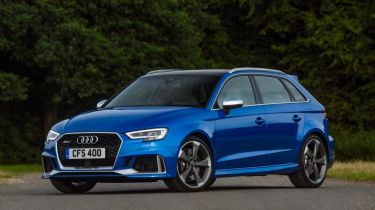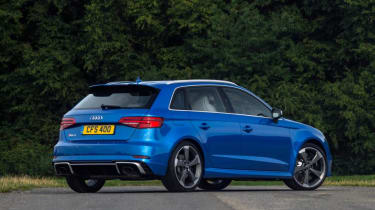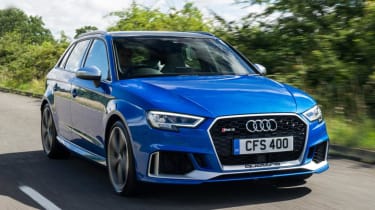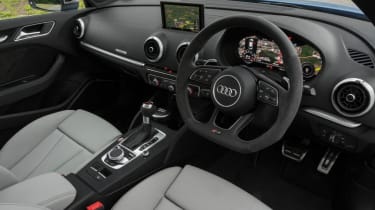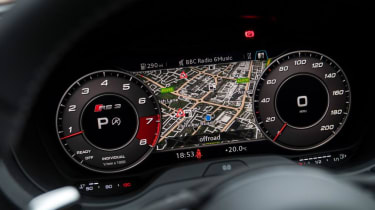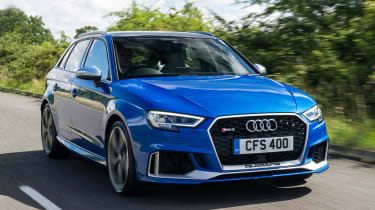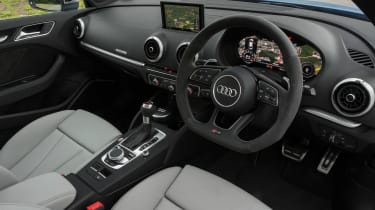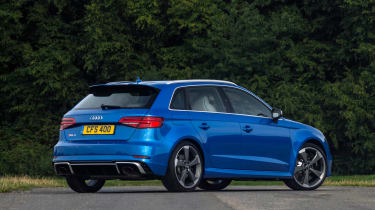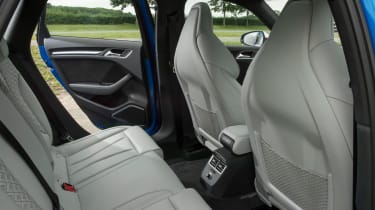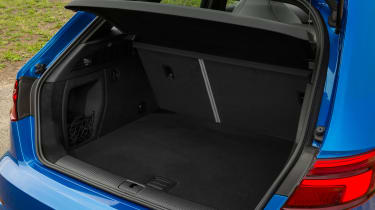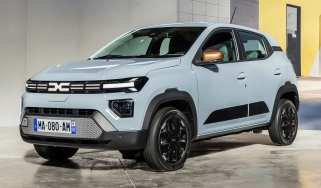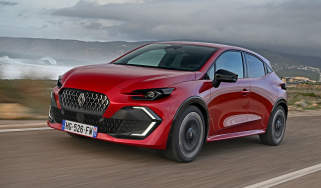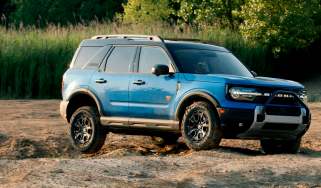Used Audi RS 3 (2015 to 2021) review and buyer's guide
A full used buyer’s guide on the Audi RS 3 covering the current generation RS 3 (2015 - 2021)
Back at the turn of the century the Ferrari 360 was a state-of-the-art junior supercar with its 400bhp V8. This Audi packs similar power in a practical package that allows you to take the whole family (and their luggage) with you.
Massively cheaper to buy and run than the Ferrari, the RS 3 is a performance-car bargain, although it’s still not cheap to own – especially if you drive it as it was designed to be driven. A quick scan of owners’ forums reveals how highly those who’ve bought an RS 3 rate it; the only downsides seem to be the big fuel, maintenance and insurance bills.
Audi is no stranger to usable high-performance cars. Ever since the arrival of the original Quattro in 1980, the company has offered fast, family-friendly models with the added security of four-wheel drive, and that’s especially the case where its thrilling RS family is concerned.
The first of the line was the 1994 RS2 estate, built in conjunction with Porsche, and ever since then we’ve had a slew of hatchbacks, saloons, coupés, estates, SUVs and convertibles with plenty of power, discreet looks and drive to all four wheels.
The RS 3 is Audi’s smallest RS model, and it happens to be the most affordable as well. This second generation version RS3 will still sprint from 0-62mph in four seconds, so it’s no soft option.
Models covered
- • Audi RS 3 (2015-2021) - Five-door hatch and saloon combine practicality and performance.
Audi RS 3
History
Audi’s original 335bhp RS 3 was on sale between 2012 and 2013; an all-new 362bhp model based on the third-generation A3 reached UK showrooms in July 2015. It was available only in five-door Sportback form, priced from £39,950 and powered by a turbocharged 2.5-litre five-cylinder engine. All RS 3s had a seven-speed S tronic dual-clutch auto gearbox.
Used - available now
A revised RS 3 Sportback was introduced in September 2017, now with 395bhp to give 0-62mph in just 4.1 seconds. At the same time an RS 3 Saloon was launched; it was mechanically identical to the Sportback but with a different bodyshell. Standard equipment was the same as before, while key options included ceramic brakes and an uprated exhaust for a fruitier soundtrack. This RS 3 was replaced by one based on the fourth-generation Audi A3 in 2022.
Audi RS 3 reviews
Which one should I buy?
You don’t have many choices to make because all RS 3s have an automatic gearbox, so it’s mainly a question of working out whether you want a five-door hatchback or a four-door saloon; the former is by far the most common body shape.
From the outset, LED headlights and 19-inch alloy wheels were standard features, as were automatic lights and wipers, Nappa leather trim, heated front seats and dual-zone climate control.
Optional extras included electric seat adjustment, magnetic ride suspension, an upgraded hi-fi and navigation. The latter was available for £495 and it’s a common fitment; it was also offered for £1,495 as part of the Technology Package that brought a larger (seven-inch) display as well. A panoramic roof is a desirable option that few cars have; it originally cost £950 extra.
Alternatives to the Audi RS 3
If you want a four-wheel-drive hatchback with searing pace, the 355bhp (376bhp from September 2015) Mercedes-AMG A 45 might suit. As with the Audi it blends accessible performance (and lots of it) with practicality and high running costs. These attributes also apply to the BMW M135i, which morphed into the M140i in May 2016. With power going only to the rear wheels rather than all four, it’s more fun to drive but less usable than the 4WD alternatives in adverse weather conditions.
If you can live with 300bhp rather than 400bhp, consider the Ford Focus RS, Honda Civic Type R and Volkswagen Golf R. All are far cheaper to buy than the RS 3, but they’re still extremely fast despite the power deficit.
What to look for
Spare wheel
Instead of a spare wheel of any kind, there’s a tyre mobility kit in the boot – and you don’t get a well for a spare wheel to go in.
Top speed
If they were willing to pay an extra £2,495, RS 3 buyers could specify the Dynamic Package Plus, which raised the top speed to 174mph.
Mirrors
You’d think heated, folding, electrically adjustable door mirrors would be standard on a car such as this, but they were a £150 extra.
Extras
Other options that are worth keeping an eye out for on a potential buy include a reversing camera and cruise control.
Interior
Based on the standard A3, the RS 3 shares that car’s classy cabin but has much sportier seats. It’s crammed with premium materials and is spot-on ergonomically, plus there’s plenty of leg and headroom in the rear. Boot space is generous as well; the Sportback has 335 litres with the seats in place and 1,175 litres when they’re folded, although the saloon offers 315 or 770 litres.
Prices
To check prices on the Audi RS 3, try our valuation tool or visit the RS 3 hub on our Buy A Car service.
Audi RS3 used prices
Running costs
All RS 3s come with variable servicing allowing 9,000 to 18,000 miles and up to two years between garage visits. An initial inspection including an oil change, along with new oil and pollen filters, is pegged at £414.
After this services alternate between intermediate and major, at £309 and £465 respectively. But these are discounted rates on the understanding that by the time the car needs its second service, it’ll be three years old; rack up the miles quickly and the bill could be higher.
Fresh brake fluid is required every two years (at £65), and because the engine is equipped with a timing chain, there’s no cambelt to replace.
Recalls
The A3 Mk3 on which the RS 3 is based has been recalled only once. The campaign, launched in November 2017, affected just 30 A3s and Q2s built in August that year, and related to rear hub carriers failing because of a manufacturing fault. It’s unlikely the RS 3 was included, but to be sure, enter the chassis number into the search facility at https://car-recalls.eu/vin-check-recalls/audi.
Driver Power owner satisfaction
The A3, S3 and RS 3 are all ranked as one model in our Driver Power satisfaction surveys, and finished 46th in the new car poll and 29th in the used survey. It’s the fit and finish that owners like the most about their Audis, with the infotainment systems winning lots of praise as well. Nothing scores badly, although running costs aren’t rated as highly as they could be.
Audi RS 3 review: what we said
Extracts from our Audi RS 3 test drive in April 2020
When it comes to brute force, the Audi RS 3 is the hot hatch (or hot saloon) of choice. What’s phenomenal is that you get so much power wrapped up in a practical package; it really is a car designed to be used every day.
Like many fast Audi models, the RS 3 prioritises unflappable all-weather performance above any truly flamboyant fun when you're driving at the limit, but as a means of getting from A to B extremely quickly it'll shame most cars twice its price. It's much better to drive than it used to be, however, with the 2017 facelift heralding some important changes under the skin.
Although the RS 3's five-cylinder engine has been around for a while, Audi has worked hard to extract all the efficiency it can, which means economy and CO2 emissions are more than acceptable than you might imagine given the enormous performance on offer.
The Audi RS 3 Sportback and RS 3 saloon are a pair of high-performance flagship models that top the Audi A3 line-up, and they provide a tempting alternative for drivers considering rivals such as the BMW M2, Ford Focus RS and Mercedes-AMG A45.
Audi first offered the RS3 for sale with a 335bhp five-cylinder turbocharged engine back in 2014, when the car was billed as the most powerful hot hatch in mainstream production. The this RS 3 performs even more strongly and in 2017 was upgraded from 362bhp to a scarcely believable 395bhp. That prodigious power output puts it ahead of both the BMW M2 (365bhp) and the Mercedes-AMG A 45 (376bhp), which is no mean feat.
WLTP emissions regulations briefly forced the RS 3 off sale, but Audi recertified it to the latest standards. Maximum power (400PS) and torque (480Nm) figures remained the same, though peak torque of now comes in a couple of hundred revs later, and the fitment of an exhaust particulate filter added a few kilos to the overall kerb weight.
Those changes are almost impossible to notice on the road though, so the RS 3 remains manically fast, aided by the traction of a four-wheel drive quattro system. In fact, with an impressive power-to-weight ratio of performance is enough to startle the average supercar, with all the added practicality of a saloon or five-door body. With launch control fitted, the RS 3 will sprint from 0-62mph in just 4.1 seconds and – if you have the electronic limiter removed – will hit 174mph flat out.
Other improvements to the latest RS 3 include faster shift times for the DSG gearbox, and faster reactions from a variable quattro system that can send 100 per cent of torque to the rear wheels on demand.
Unlike the main A3 range, there’s no three-door RS 3 hatchback model. If you want five-door practicality you need the RS 3 Sportback which is mid-way between a traditional hatchback and an estate.
Both the five-door RS 3 Sportback and four-door saloon versions come with a very acceptable level of luxury, and the spec sheet includes RS specific body styling, big 19-inch alloy wheels, and sports suspension that’s 25mm lower than standard.
The RS 3 also comes with auto comfort and dynamic modes as part of Audi Drive Select, plush Nappa leather upholstered sports seats, LED lighting, all-round parking sensors, brushed metal pedals, plus sat-nav, DAB digital radio, Bluetooth and a 5.8-inch colour display. Audi’s magnetic adaptive dampers are a £995 option.
In 2019, Audi introduced the Sport Edition trim. For £4,000 over the price of the standard model, which adds a range of subtle styling changes, a panoramic sunroof and, most importantly, a sports exhaust system. It’s an upgrade worth choosing for the exhaust alone.
Engines, performance and drive
A launch control function lets you feel the full force of the RS3’s acceleration. Activate it and the way all four tyres dig in and slingshot you up the road quite literally takes your breath away.
Refinement is excellent on smooth surfaces, although the standard RS sports suspension can feel a little harsh when the surface breaks up – we’d recommend forking out for the optional adaptive dampers. But being civilized isn’t what the RS3 is about.
Go for the Sport Edition model, and selecting the dynamic mode via the drive select button opens up flaps in the sports exhaust and all hell breaks loose. The RS 3 rewards you with explosions on the overrun, burps on gear upshifts and a snarling soundtrack when you’re on the throttle. The five-cylinder turbocharged engine makes a glorious noise, and one which makes the RS 3 more thrilling than the four-cylinder alternatives.
The variable ratio steering system is fast and direct, and body control impeccable when you keep things smooth and simple. Approach the limit, and there’s more adjustability than you’ll get in, say, the VW Golf R, if not quite the playfulness of the rear-driven BMW M2. The best body control comes in sport mode at the slight expense of ride comfort. Leave the settings in comfort and, at speed, there’s slightly less control over sharp bumps which cause vertical movement.
The optional two-tone 19-inch alloys actually get wider tyres at the front than the rear, which helps boost front end grip a little. Yet with that heavy five-cylinder engine hanging over the axle and four-wheel drive system that's calibrated for ultimate traction over agility, the RS 3 will eventually run wide in a corner. However, those limits are so high that they’re rarely reached on a dry road.
For accomplished drivers the rear-wheel-drive BMW M2 will be more fun, however.
Engines
The turbocharged 2.5-litre five-cylinder engine stuffed under the bonnet gives the Audi RS 3 electrifying performance. With 395bhp (up from 362bhp in the pre-facelift car) and 480Nm (boosted from 365Nm) at your disposal, there’s massive performance on tap whenever you need it.
Aided by four-wheel drive, which maximises traction off the line, the RS 3 will rocket to 62mph in a claimed 4.1 seconds. The top speed is electronically limited to 155mph, although if you fork an extra £1,600, Audi will tweak the limiter giving you a maximum of 174mph instead. That’s a lot of extra cash for something that hardly anyone will use, though.
Unfortunately there’s no manual gearbox option, but those meaty torque figures do mean the RS 3 is quite happy letting the seven-speed twin-clutch S tronic auto change gear seamlessly. Trickling around town in a higher gear is relaxing as any other A3 in the range, but pick up the pace and the gearbox responds crisply to the wheel-mounted paddles.
It sounds pretty fruity, too, particularly in Dynamic mode, when the gearbox's downshifts elicit hilarious cracks and bangs from the exhaust.
MPG, CO2 and running costs
While other performance cars were ‘downsizing’ engine capacity and numbers of cylinders, Audi stuck with the characterful 2.5-litre turbocharged five-cylinder engine. This has inevitable consequences for the RS 3's fuel economy and efficiency.
For the performance on offer, however, the RS 3 returns competitive figures, with claimed economy and emissions of 29.7mpg and 215g/km on the WLTP test cycle – and those numbers are identical, whether you go for the hatch or the saloon. By comparison, the 296bhp four-wheel drive VW Golf R with a DSG gearbox returns 32.8mpg and 197g/km - though it can’t compete with the Audi for outright speed. On paper, the BMW M2 Competition is almost an identical match for the Audi in terms of both emissions and fuel consumption.
Of course, the figures recorded on an official test cycle and the realities of everyday driving are two very different things. In the worst-case scenario, taking your car to a track day would likely see a return of less than 10mpg, whereas if you take things very easily and you might see this figure creeps into the low 30s. Expect something in-between and you won’t be disappointed – and remember that’s still pretty good for a car with the RS 3’s sizzling performance.
Interior, design and technology
Audi’s RS models are usually designed to fly under the radar and the new RS 3 sticks to the brief – although fans of fast Audis will spot one a mile off.
On top of the obvious badging, the single-frame grille is filled with a gloss black honeycomb mesh with bigger air intakes either side. LED headlights with LED daytime running lights are standard, too, along with RS-specific colours and trims. All cars get 19-inch alloy wheels, bespoke for the high-powered hatch and saloon, while matt aluminium wing mirrors, a roof spoiler and two gaping oval exhausts finish off the subtly pumped-up look.
The Sport Edition model adds some subtle styling upgrades, including a black finish for the grille surround, window trims, rear diffuser and alloy wheels. Inside, the Sport Edition adds some more supportive sports seats and flashes of carbon fibre trim.
If you are dabbling in the options list – and it's quite a long one – there are plenty of ways to personalise your RS 3. You can remove the 155mph speed limiter for £1,600, while Ceramic Brakes cost £4,695. The £1,000 sports exhaust is well worth the extra, too.
The standard A3 Sportback’s interior is already a pleasant place to spend time, and the RS 3 version turns things up a notch with a pair of gorgeous wingback sport seats, finished in quilted leather. A flat-bottomed steering wheel trimmed in Alcantara feels fantastic in your palms, while the instrument cluster is upgraded with a digital boost meter for the turbo.
Standard kit inside includes the retractable screen for displaying the sat-nav, rear parking camera and infotainment functions.
Sat-nav, stereo and infotainment
The latest RS 3 comes with a clear colour screen as standard, with Apple CarPlay and Android Auto connectivity included. It's fairly intuitive to use through the click wheel located on the centre console, but alongside the latest touchscreen infotainment systems it’s starting to show its age. The seven inch screen is small, too, but at least the 12.3-inch ‘Virtual Cockpit’ digital dials look great. A Bang & Olufsen stereo and wireless phone charging are also available.
Practicality, comfort and boot space
Few cars at the RS 3’s level of performance offer such a practical layout. Available in two body styles, the more practical model is the conventional Sportback. With five seats, five doors and a versatile hatchback layout, it's almost as versatile as the standard A3 – although the boot capacity of 335-litres is 45 litres less than the standard A3 Sportback.
Inside, deep door bins and lots of cubby holes and cupholders make the most of the available space. There's also a large glovebox and a deep lidded compartment between the front seats. Speaking of which, the Audi’s wingback sports seats don’t just look fabulous – they’re comfortable and supportive too, with a driving position that’s adjustable for all shapes and sizes.
The RS 3 Saloon is impressively practical, too, though the lidded boot is means the raw numbers are a little deceptive. Like its hatchback sibling, the 315-litre loadbay is smaller than the standard A3 Saloon's – though in this model you lose a whopping 100 litres of carrying capacity.
Elsewhere, the firmer suspension naturally makes the RS 3 that little bit more tiresome than an A3 diesel on long journeys and over poor surfaces. But with its surfeit of power and quiet cabin when cruising, the RS 3 is nonetheless well suited to long road trips. Just be aware that you’ll be stopping to top up with fuel fairly often, as the standard A3 fuel tank is a fairly modest 55 litres.
Size
The RS 3 Sportback is 4,335mm long and 1,800mm wide, which puts it on par with the Mercedes-AMG A45. At 4,479mm, the RS 3 saloon is a bit longer than the Sportback, while the lengthier rear overhang makes parking trickier.
Leg room, head room & passenger space
Audi has added an extra 35mm to the RS 3's wheelbase (the distance between front and rear axles) over the three-door A3, which frees up some welcome legroom in the rear – even six-footers will be comfortable back there.
While the car is a full five-seater, two rear passengers will be much more comfortable than three because shoulder-room will otherwise be severely limited. There are standard ISOFIX child seat mounts on the front passenger seat and the two outer rear seats.
Boot
This is where the Audi's practicality credentials take a hiding. The standard A3 Sportback boasts a useful 380-litre capacity, but the RS 3 can only accommodate 335 litres, which is only slightly larger than some superminis. This reduction is a result of the need surrender underfloor space for the four-wheel drive system's back axle and the battery (the large five-cylinder engine means there's not enough space under the bonnet).
Drop the rear seats and the usable loading area jumps to 1,175 litres – which is more than the Mercedes-AMG A45 can offer. There’s a decently low loading lip too, while the Sportback’s estate car-like lines help to maximise practicality.
The RS 3 Saloon is smaller still, at 315 litres. The seats split and fold as standard, but Audi hasn't issued a total boot space volume figure.
Get even more from Auto Express, follow our channels...

